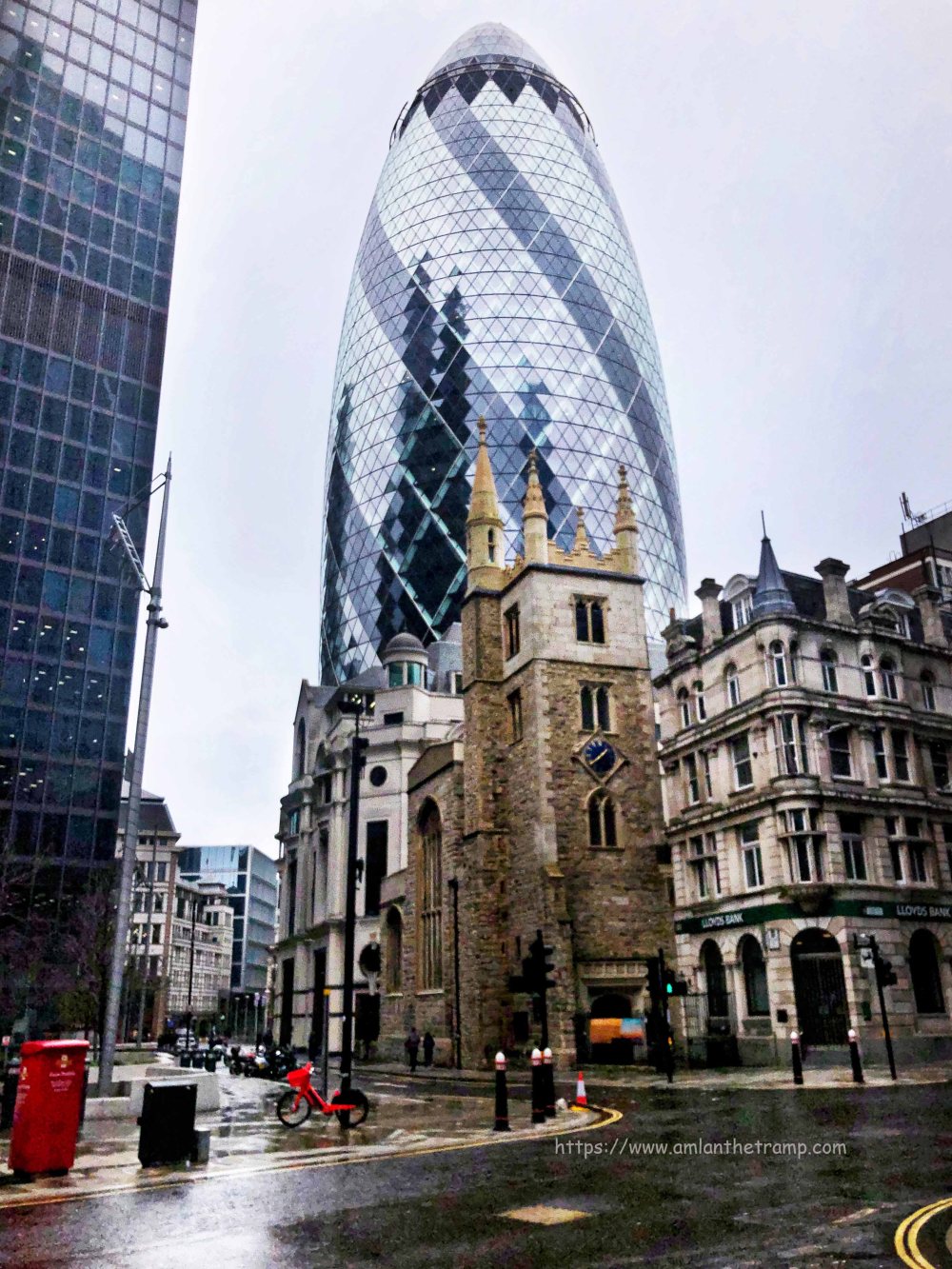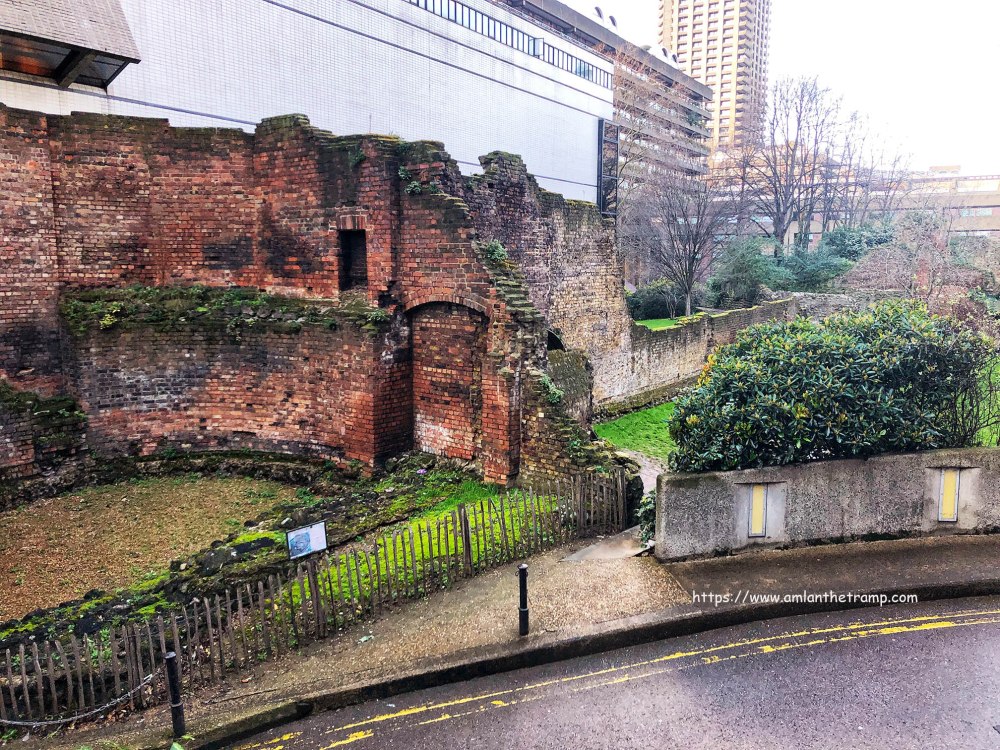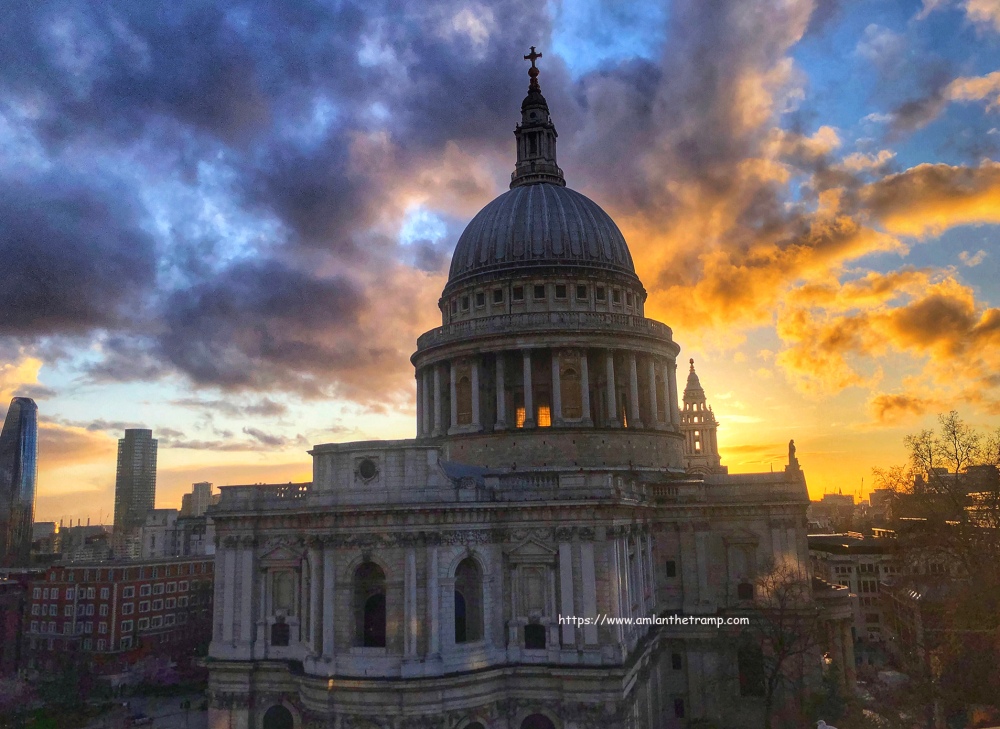“City of London” is the oldest part of London, the capital of the United Kingdom. Located on the northern bank of the Thames River, this one square kilometer area within London Bridge and Blackfriars Bridge is obviously the oldest part of the city or can be regarded as a city inside a city. It has its own mayor. This London neighbourhood has an archaeological value. This area contains more than 1000 years old Roman Wall, baroque churches, old fashioned houses, contemporary architectures and flamboyant skyscrapers. The tangle of narrow passageways, big courtyards, tiny bi lanes impulsed me to get lost. Today I will share my experience.

It was a cold and cloudy afternoon in London, the capital of the United Kingdom. After having lunch I came out with my camera and planned to have a walk on the narrow passageways of the “City of London”.

I was walking in a narrow alley, suddenly I found an old man walking beside me. His face was covered by a mask, even my face too. It was the middle of March 2020, when people started affected by the pandemic flu of Covid-19 virus.

“Hi Gentelman!!”, He interacted with me, “You are a traveller, right?”
I greeted back, confirmed my identity and asked about him.
“I am History.” He replied.
I looked at him quizzically.
“I have been living in these alleys since the time of Jesus Christ. I have seen the city to be built, attacked, destroyed by Nors, devastated by plague, burnt by fire, rebuilt with british will power and acknowledged as the capital of the World. If you are interested to know, I can tell you.” He paused and asked for a cup of coffee.

We went to Leadenhall Market. Established in the 14th Century, the market is actually full of restaurants where dining is an unique experience. Leadenhall Market is in the center of the City of London. On a normal day, people love to sit outside of the restaurant (like the entire Europe during Summer), but as I mentioned, due to the outbreak of Covid 19 Virus, the restaurants were closed.

Luckily, The God Yard, a famous cafe in Leadenhall Market was open. We went inside and ordered two cups of Americano.
“Do you know the etymology of the word London?” History asked me.
“As much as I know it is derived from the Celtic word ‘Londonios’”, I replied
“And the meaning?”
“The place of the bold one.”
“Do you know, why and how the city was born?”
“No”
“Okay, I will tell you.” Meanwhile the coffee was served. The flavour of the coffee was telling its class. History took a sip and started, “The city was born by Romans in 50 AD. They invaded Britain in the 43rd Century and founded a bridge on the river Thames. Which is known as the London Bridge. They liked the place and since the river is wide and deep enough for ships they planned to build a port. Geographically London was important as it was close to Northern Europe and also it was safe from German raiders. But the city was attacked Norse in the 11th Century and pulled down the wooden deck of London Bridge. The bridge collapsed.
“And the popular rhyme originated from there?” I interrupted. History confirmed.
“But the city recovered quickly and mediaville London was known for its remarkable living standard. Next 300-400 years were extremely good but again the city faced two consecutive rapid disasters – Fire of London and Plague.
Meanwhile our coffee was finished. We came our and on a right turn, we saw Gherkin, the most beautiful skyscraper. Interestingly, this flamboyant building is not hampering the cityscape. Instead, added a dimension in the skyline. Just like, veteran lady and her granddaughter stay together in a family.

History guided me to the Monument. I offered a cigarette to History. He smoked a dip puff, blew a smoke ring and started speaking. “Look at the street name”
“It’s Pudding Lane.”
“The lane was named after Thomas Farriner’s bakery. On 2nd September, 1965 around 1 PM the fire was raised from the oven of the bakery. The fire spread very quickly as the area around Pudding Lane consisted of warehouses with ropes, oil and timbers. Moreover the weather was very dry that time. After devastating the city for three days with the help of the army, Londoners could pacify the fire. 436 acre of London was destroyed including 13200 houses and 87 churches, St. Paul’s Cathedral was abolished, 80000 people were homeless.” History stopped, smoked another puff.
“Even God could not save himself!!!” I asked sarcastically.
“God can not save himself.” History replied.
“Was it just an accident or it was intentionally raised?” I asked
“Officially it was an accident but conspiracy theory says it was committed by French traders who were not allowed to get into London. Let’s leave it.”

We came in front of The Monument. The full name of the Monument is Monument to the Great Fire of London. Commemorating the tragic incident, The Monument was built on the site of St. Margaret, the first church destroyed in the fire. Climbing to the top of The went to the back side of Monument. The monument was A lovely sculpture depicted there. The inner meaning of the sculpture signifies the oath taken, “London will rise and rule the world again.”
“Was it the beginning of the superpower Britain?” I asked History.
“Yes. The monument was built by the great architect Sir Christopher Wren, who was actually a mathematician and physicist. He reconstructed 51 churches in his own design. Earlier, he could not build domes, so the initial churches did not have domes. Let’s start seeing them.”

We started walking. Crossing Eastchip walked along A1213 and finally turned east to Lombard Street. The road was full of old British ethnic houses though some flamboyant buildings have been constructed but the aesthetics were not hampered. We stopped in front of St. Edmund Church. The first church constructed by Wren. We walked further.

“Within a few years, London regained its position and the great Financial Hub was established. Most of the international banks in the world have at least one branch in this hub and also have 2-3 branches in the vicinity. Even now, this financial hub generates the highest revenue in the world.”

He was right. I found the branches of almost every bank that I know in this area. Even the tube station “Banks” is there. Even some of the banks have multiple branches in the nearby area too.

The first thing I noticed in Lombard Street is the hanging signs from the old buildings. Each of the signs were different from others. In fact the signs were random – anchor, queen’s face, grasshopper, I asked history about their symbolic values.

“Lombard Street and its environs became home to small goldsmiths, or family-run banks. But common Londoners were not that much educated. How would they read the numbers? So the concept of hanging signs were invented.”

“So every hanging sign signifies addresses?”
“Yes it was.” History replied, “Anchor & Crown was for London & Country Bank, while grasshopper was for Messrs. Martin Bank. Each of every sign has its own values.

Later I found a great list from one website. I am giving the image below:
We continued walking towards the east. In front of a building, I found a plaque mentioning “Site of Lloyd’s Coffee House”.

“This is the site of the first coffee house in the world. Or you can say this is the birthplace of modern day’s insurance.” History replied.
“Really?” I was a bit surprised. How a coffee house can be the womb of insurance!
“Yes my young friend”, History smiled and continued, “Obtaining impetus from the great fire of London, the concept of insurance arose. The merchants gradually became afraid of securing their assets and shipment. Edward Lloyd, at the age of 41, established a coffee house patronized by the merchants, bankers and insurance underwriters. Llyod supplied the shipping information from the docs and personal intelligence. Gradually it became the most likely place by the Marine Underwriters as they collected data from one single point. Eventually, the coffee house grew a publication list named as Lloyd’s List. The list still exists both in printed and web format. Nevertheless, two most important and successful English insurance companies were formed during this period—the London Assurance Corporation and the Royal Exchange Assurance Corporation by collecting information from Lloyd’s Coffee House.”
The breathtaking story surprised me like anything. But still there were lots of surprises waiting for me. We proceeded further toward the east and then turned left to Post Office Court.

History lighted one more cigarette and said, “I have already shown you the birthplace of insurance, now I will show you the womb from where today’s postal code was conceptualised.” He pointed his finger to a building where I saw a plaque where “Post office court” was written.
“Since London was gradually flourishing as a trade hum, mailing was very frequent. But it was tough to maintain accuracy of the location. Thus the city was divided into 10 postal divisions. The idea was conceptualised in this building.”
I was feeling goosebumps in each and every step. History took me to the world of the 18th century. Gradually I was acquiring knowledge about how a modern city was built and why Britain is regarded as the most systematic country.
We took a narrow passageway adjacent to Mansion house and after a right angled turn the alley became narrower to St. Stephen’s Row. The lane was so narrow that two people could not walk simultaneously. It ended at a beautiful green domed church – St. Stephen’s Church, another masterpiece of Sir Christopher Wren.

As mentioned earlier, Bank is an ever crowded tube station. But the junction is also famous for Mansion House – the House of London’s Mayor. The Palladian Style wide building is used for hosting the City of London’s official functions.

We took a right turn to a narrow alley, crossed Cornhill, followed by a left turn to Theadnell Street and reached the backside of the Bank of England Museum. The museum has a huge collection of old currencies and different bank stationary.

We walked straight, crossed Moorgate and walked further along Gresham Street. After a sharp right turn we reached Guild Hall.

The medieval building Guild Hall has a cathedral like architecture with an excellent interior. This the place where old meets new. The hall attracts people on a journey spanning more than 800 years.

Admiring the beauty of the building we further walked further east and after a right turn we went to Wood Street. Walking further along Wood Street towards the north we reached in front of London City Wall.

London City wall is the last Roman archaeological remains of the city. The wall was not entirely destroyed by the fire and preserved well.
Walking along the Roman Wall towards the east we reached the Museum of London. We turned left to Aldersgate Street and walking towards the south finally we arrived at the world famous St. Pauls Cathedral.


St. Paul’s Cathedral was our final destination. One of the most beautiful architectures I have ever seen in my life. The Anglican Cathedral was first built on Roman age, devastated in the Great Fire of London and reconstructed by Christopher Wren. The English Baroque style building is white with a green round dome.

Moving round the cathedral our trip came to an end.

I thanked history for being with me. Finally we went to a roof top pub opposite the cathedral and shared beer.

Dusk was about to set in. The golden rays of the Sun were on the backdrop of the dome on the cathedral. It seemed like a historical drama was performed in front of my eyes.

References:
- https://lookup.london/hanging-signs-lombard-street/
- http://www.localhistories.org/london.html
- https://www.britannica.com/topic/insurance/Historical-development-of-insurance
- https://www.lr.org/en-gb/who-we-are/brief-history/edward-lloyd-coffee-house/
